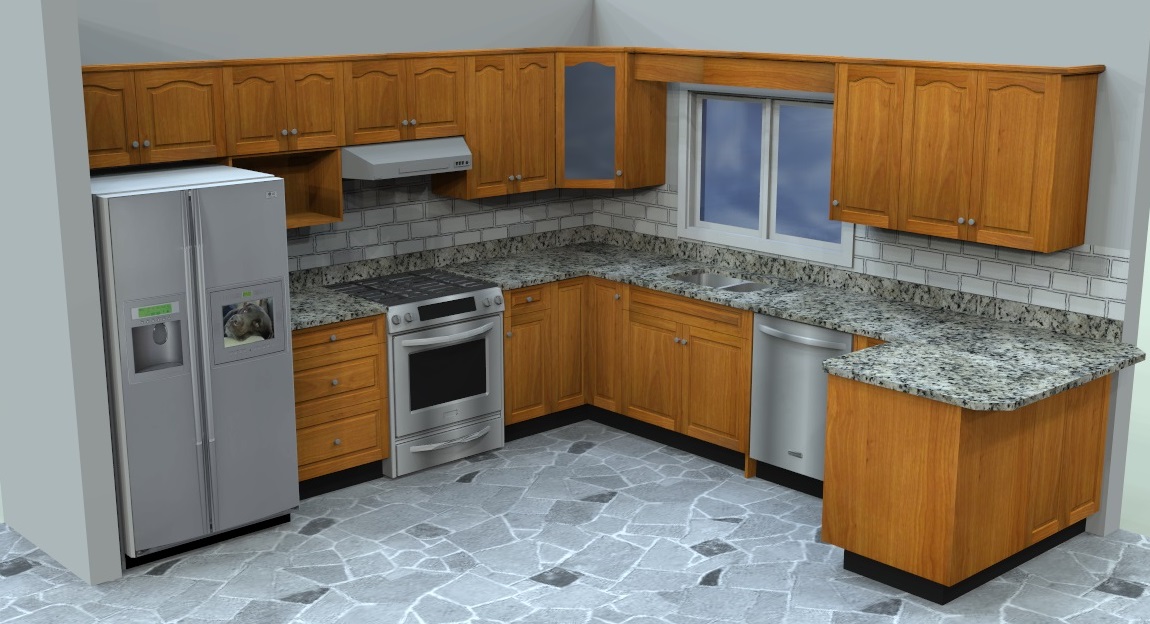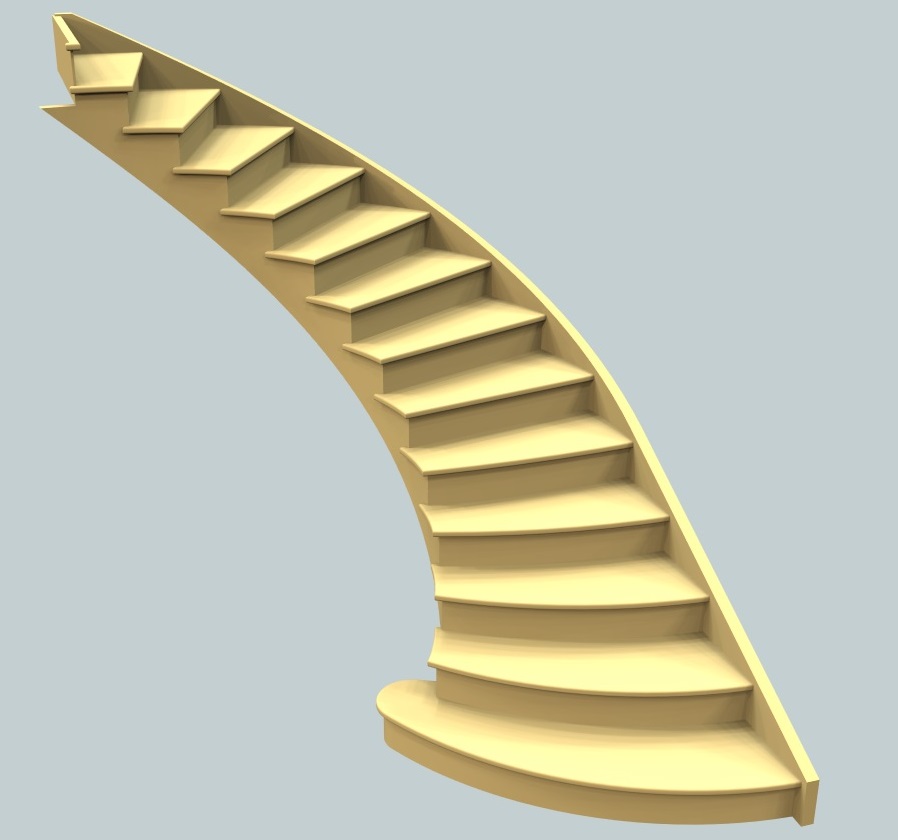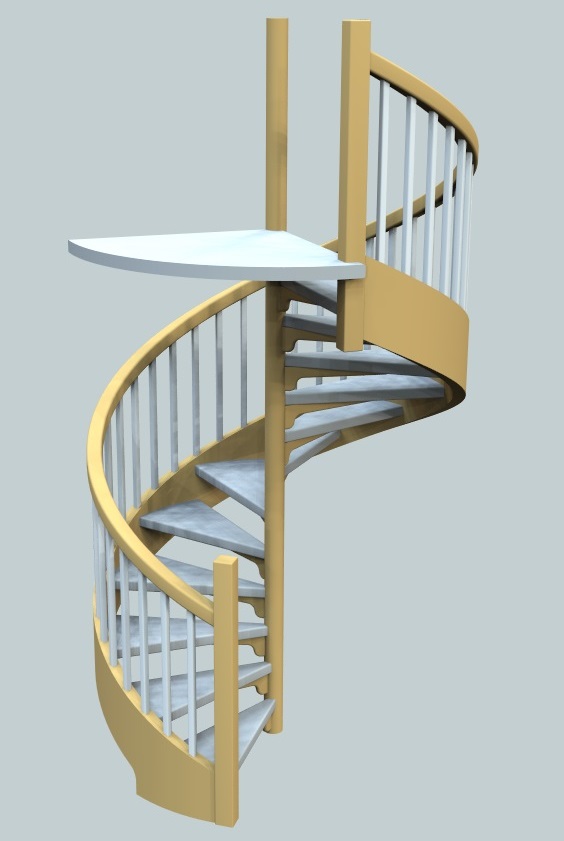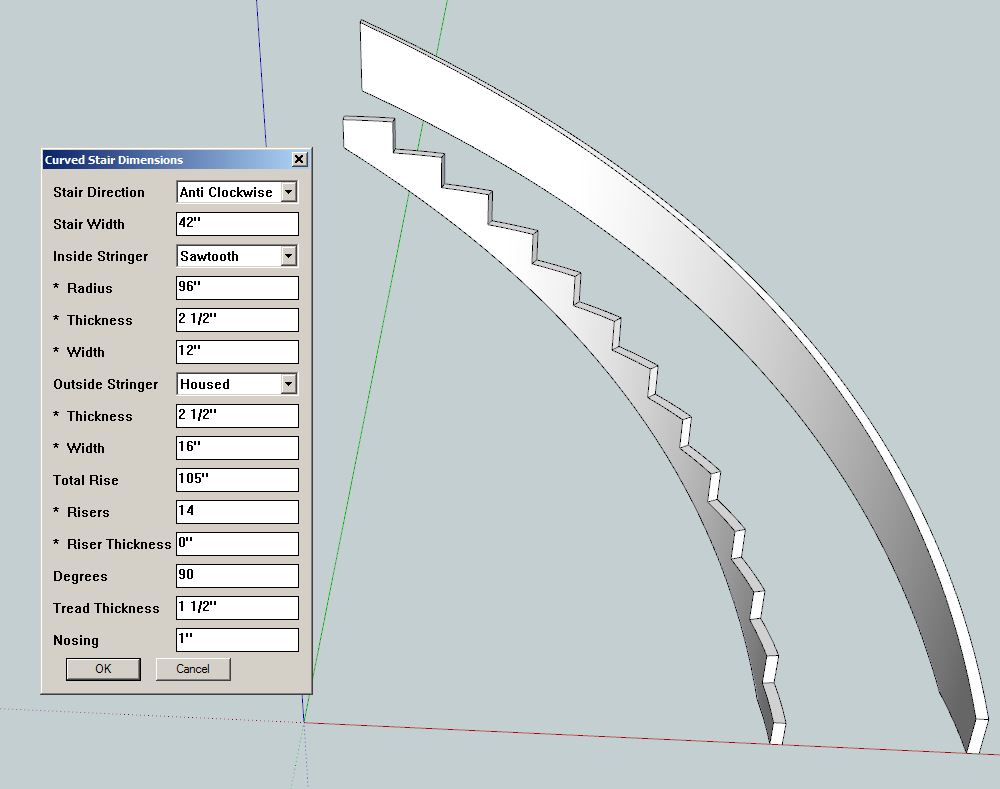Curved Staircases
-
As far as modeling goes - I was pretty impressed with the ease of use of IRender nxt.
Here are a couple of models - a Kitchen and a couple of stairs.



-
Garry,
Nice examples shown.
Thought I would share a stair set that I was "forced to build" as the existing framing prohibited conventional stair set options. (rise & run extremely "short" & HVAC tightly roughed over head)
Not sure of the proper term for this type of stair set...but "card fan" comes to mind.
I maintained 10" tread at the "walk line"........12" "in".
Built the stair set as individual "carriages".
Cannot seem to locate the actual finished pics....will upload if I find some.
Charlie
-
I would call this stair a modified winder. As far as the Walk Line is concerned - you need to consider the outside edge of the handrail to a distance that is directly vertical between your legs. You also need to look at the speed of egress. This is considered to be moving quickly and moving down the stairs and thus out of the building. The slower that you walk the closer you are to the edge of the stair - the problem of safety is when you are moving quickly. You also have to consider larger people. These considerations dictated our walk line to be 20" from the outside edge.
The trick is to build a safe stair - and one that is reasonably easy to build and also easy on the eyes.
I would work out calculations to see if it was possible to have a consistent pitch at the inside stringer, the outside stringer and also at the walk line and all the while maintaining a safe stair. That is the challenge.
-
I have started to build the curved staircase plugin.
Hopefully this shows you where I am going with it.
The input box remembers your settings between uses while in the same session.
I may include a text file of defaults that you can change so that your own defaults appear every time you start sketchup and run the Stair Maker.I plan to add an option so that your stair will straighten out for x treads at top and at bottom. The default will be 0 straight treads. You will also specify the run of the straight treads.
Any feedback during this stage would be much appreciated.
-
awesome... imperial too?
-
Yes it sees what your setup is at startup and stays with that - metric or imperial.
You are stuck with that choice until next startup.I've got the plugin working so there aren't any extra faces that need to be deleted.
The soften tool shows that up in a hurry.I have the sawtooth working for open risers (set Riser Thickness to 0.inch or 0.mm). I need to adjust the sawtooth for risers that have thickness.
The Stair width will be overall width of stair which includes the stringer thickness if housed and includes the tread overhang ( same amount as nosing ) if sawtooth.
The only extra work that I have done so far is orient faces and apply the softening.
Not a real big problem.I want to add in stringer feet and stringer heels which will represent a fair bit of work.
So I'll probably go to treads next. I will create a curved tread as component and then copy rotate and move ( which I believe are transforms - I'll find out when I get there ).

-
That's fantastic Garry... Very exciting.
-
I had a bit of issue with some coding - but I believe that I am past that now.
In the mean time. Here are 2 more stairs. The first one has a single center stringer that I set to 120 mm thick and 400 mm wide. The treads are 3 layers of 3/4 plywood glue laminated - so I set the tread thickness to 57 mm. I set the outside stringer to none so it wouldn't build it.
Notice that I told the plugin 0 for riser thickness. I built the stair and then deleted the treads. I did add texture to the stringer and then when the treads were created I added texture to them and then I uses the round corners tool to ease all the treads to 1/2" bullnose.
I ran the plugin a second time ( it remembered all my settings ) and changed the inside stringer to none as well as the inside. I then changed the inside radius to 2400 and built the stair without stringers on top of the first one.
The second stair is an example of an outside concrete stair. In this case I set the outside stringer to none and turned of risers and treads by setting their corresponding thicknesses to 0.
-
Here is an unusual stair case. Anyone up for this challenge?
-
and I thought I was strange...
-
Plugin is at the next stage. Treads and Risers are finished. Notice that there are still some things to do. The Housed stringer at the bottom and at the top is not finished. I need to extend the housed stringer 2 X Nosing. Also the Nosing on the top riser is missing.
I've added a floor thickness which currently makes the top riser board flush with the floor.
Also added a stair_defaults.txt file which contains a few items that aren't controlled by the input box. Every entry in the input box has a metric and an imperial entry in the text file. So you will be able to set your own defaults like tread thickness and dado values etc.
The Plugin does not bullnose (round over) the treads. I've use the Round Over 3D plugin to accomplish this task as it only takes a couple of minutes. For a sawtooth, housed stair with riser boards I first drew a vertical line on the back of tread 12.7mm from the inside curve.
This is to control the extent of the round over. I then picked the edges that I wanted to round over and then performed the roundover. Notice that it does work properly where the riser board dado is. Just make sure that you pick the edges as in the picture.
-
Here is what the stair_defaults.txt file looks like.
-
Top nosing and extending housed stringers are now working.
Here is a 180 degree housed, stair with open risers.
To make the handrails I set both the Riser Thickness and Tread Thickness to 0. I then adjusted both stringer widths and stringer thicknesses to 90 mm. This tells the Stair Maker plugin to build handrails and have the tops of the rails at 800 mm above the nosings which is building code for indoor residential stairs.
-
I have created a video on you tube
http://www.youtube.com/watch?v=TQ94u6bpLq0 -
that would save me like 3 hours... or maybe more.
-
You must be pretty fast. It was taking me the better part of a day to draw stairs. Perhaps because of the amount of detail that I was interested in.
Did you view the You Tube video? What did you think of it? Do you have any suggestions or comments on what I have done so far? Have you been to my website?
-
I have been to the site, but I was looking at the cabinet program... you should have your website in your signature so people check out your great plugins from where ever they might be reading your posts.
I watched the video and it seems really easy to use and straight forward. It will be a great time saver and make for a cleaner group of geometry as well. I don't have any thing to add, it seemed really straight forward.

As for time to build the stairs, it doesn't usually take too long, especially for regular curves.
- I draw everything out in a 2D plan view.
- Then separate into a few groups; stringers, rails and steps.
- I push pull the steps up to their desired riser heights.
- Then I push pull the stringer up to the height of the top landing stair.
- Then I use Curve Shearing plugin to cut out the stringer top line, then copy that line down the depth of the stringer.
- Repeat for each side of the stringer.
- Then intersect the planes with the Curve Sheared lines.
- Delete the unneeded faces.repeat for each stringer.
- Then I use the "From Contours" native SU land drape tool or Fredo's Curviloft to make a top and bottom side of the stringer.
- Repeat for each stringer.
- I used to repeat that process for the rail but now I use Instant Rail and it gives me all the kool options and details for the railings.
- then I push pull some bullnose and call it done.
-
I've got the cleanup working to simulate stringer routing for housed stringers.
I'm going to add a configuration variable so that you can adjust the height of the housed stringer. There may be times when you want the housed stringer higher - so more of the stringer would be visible above the treads.Next step is to see what I can do about bullnosing the treads. I'll add the bullnose radius to the input box.
After that I'm going to look at flaring the treads. I'm thinking that a progressive flair of a flair amount like 1/2" might work well. Say you want to flare the bottom 6 treads - you would end up with the bottom tread flared out by 3", the one before at 2 1/2" etc.
Then add straightening of the outside stringer at top, bottom or both and optional straightening of the inside stringer.
There is also the idea of what I call a notch - this is where the stair starts out between 1 or 2 walls and part way down the stair one or both walls are now only below the stair - allowing for spindle railing. In this case the stair gets wider by the appropriate amount based on the thickness of the wall and the type of stringer.
Any comments?
-
Looks good. Sorry, you're so advanced at this I couldn't add anything.
Kris "Instant Rail"? Is this "Instant Wall" or has Chuck refined the rail functions???
-
Instant Fence/Rail is different... but the same. different plugin but same basic features just many presets and few more/different options.
Advertisement







